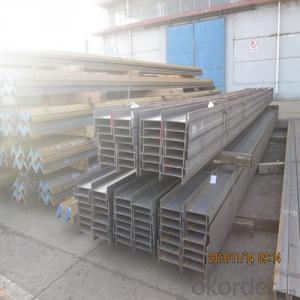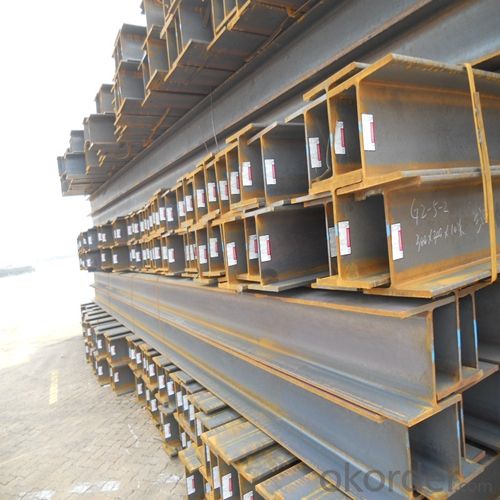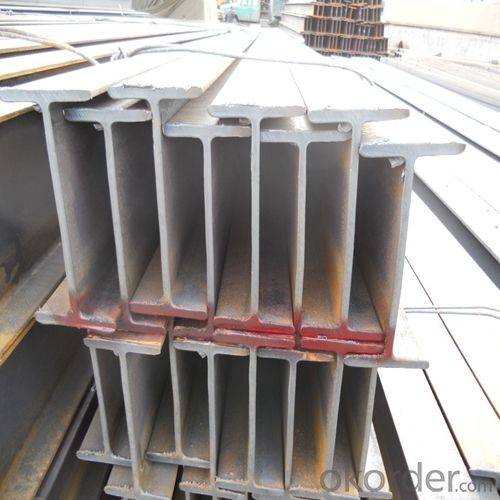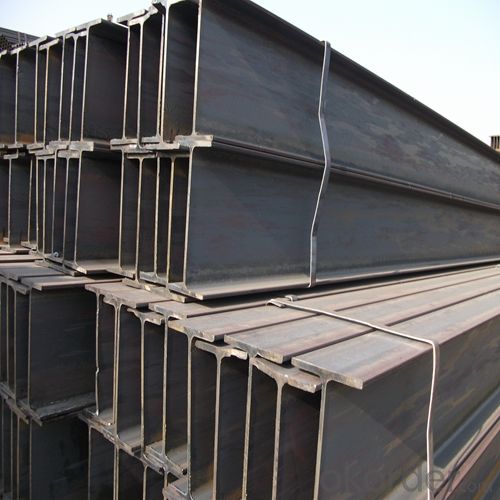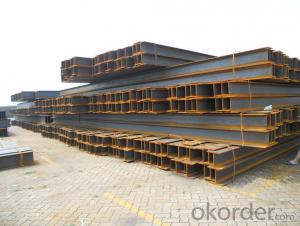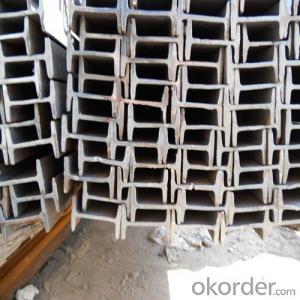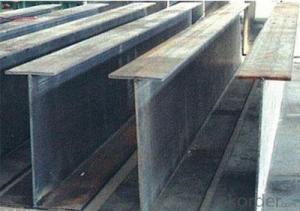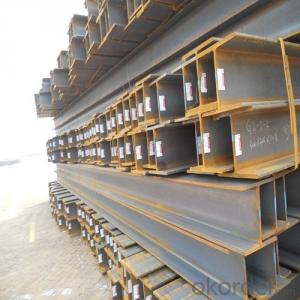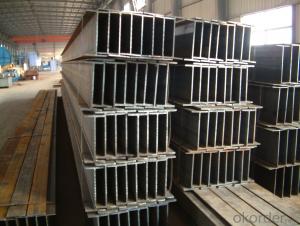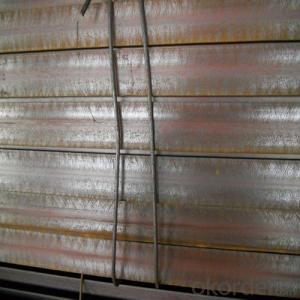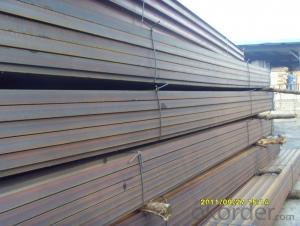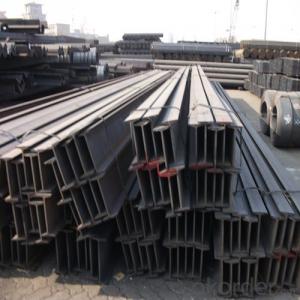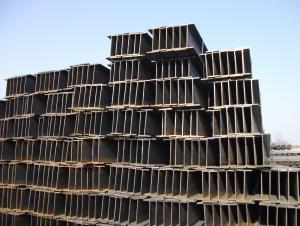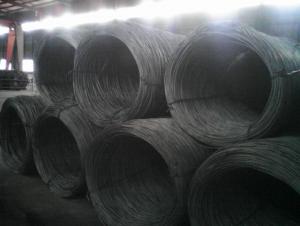Hot Rolled H-Beam Structure Steel Q235 High Quality Good Price
- Loading Port:
- Tianjin
- Payment Terms:
- TT OR LC
- Min Order Qty:
- 500 m.t.
- Supply Capability:
- 5000 m.t./month
OKorder Service Pledge
OKorder Financial Service
You Might Also Like
Product Description:
OKorder is offering Hot Rolled H-Beam Structure Steel Q235 High Quality Good Price at great prices with worldwide shipping. Our supplier is a world-class manufacturer of steel, with our products utilized the world over. OKorder annually supplies products to European, North American and Asian markets. We provide quotations within 24 hours of receiving an inquiry and guarantee competitive prices.
Product Applications:
Hot Rolled H-Beam Structure Steel Q235 High Quality Good Priceare ideal for structural applications and are widely used in the construction of buildings and bridges, and the manufacturing, petrochemical, and transportation industries.
Product Advantages:
OKorder's Hot Rolled H-Beam Structure Steel Q235 High Quality Good Price are durable, strong, and resist corrosion.
Main Product Features:
· Premium quality
· Prompt delivery & seaworthy packing (30 days after receiving deposit)
· Corrosion resistance
· Can be recycled and reused
· Mill test certification
· Professional Service
· Competitive pricing
Product Specifications:
Specifications of Galvanized H beam
1. Invoicing on theoretical weight or actual weight as customer request
2. Length: 6m, 12m as following table
3. Sizes:Zinc Thickness :15-80μ
Model Number | specification | sectional area | theoretical weight | |||
H*B | t1 | t2 | r | kg/m | ||
100*100 | 100*100 | 6 | 8 | 10 | 21.9 | 17.2 |
175*175 | 175*175 | 7.5 | 11 | 13 | 51.43 | 40.3 |
200*200 | 200*200 | 8 | 12 | 16 | 64.28 | 50.5 |
200*200 | 200*204 | 12 | 12 | 16 | 72.28 | 56.7 |
250*250 | 244*252 | 11 | 11 | 16 | 82.05 | 64.4 |
250*250 | 250*250 | 9 | 14 | 16 | 92.18 | 72.4 |
250*250 | 250*255 | 14 | 14 | 16 | 104.7 | 82.2 |
300*300 | 294*302 | 12 | 12 | 20 | 108.3 | 85 |
300*300 | 300*300 | 10 | 15 | 20 | 120.4 | 94.5 |
300*300 | 300*305 | 15 | 15 | 20 | 135.4 | 106 |
350*350 | 338*351 | 13 | 13 | 20 | 135.3 | 106 |
350*350 | 344*348 | 10 | 16 | 20 | 146 | 115 |
350*350 | 344*354 | 16 | 16 | 20 | 166.6 | 131 |
350*350 | 350*350 | 12 | 19 | 20 | 173.9 | 137 |
350*350 | 350*357 | 19 | 19 | 20 | 198.4 | 156 |
400*400 | 388*402 | 15 | 15 | 24 | 179.2 | 141 |
400*400 | 394*398 | 11 | 18 | 24 | 187.6 | 147 |
400*400 | 394*405 | 18 | 18 | 24 | 215.2 | 169 |
400*400 | 400*400 | 13 | 21 | 24 | 219.5 | 172 |
400*400 | 414*405 | 18 | 28 | 24 | 296.2 | 233 |
400*400 | 400*408 | 21 | 21 | 24 | 251.5 | 197 |
400*400 | 428*407 | 20 | 35 | 24 | 361.4 | 284 |
600*200 | 606*201 | 12 | 20 | 24 | 153.3 | 120 |
700*300 | 692*300 | 13 | 20 | 28 | 211.5 | 166 |
700*300 | 700*300 | 13 | 24 | 28 | 235.5 | 185 |
200*150 | 194*150 | 6 | 9 | 16 | 39.76 | 31.2 |
200*175 | 244*175 | 7 | 11 | 16 | 56.24 | 44.1 |
300*200 | 294*200 | 8 | 12 | 20 | 73.03 | 57.3 |
350*250 | 340*250 | 9 | 14 | 20 | 101.5 | 79.7 |
400*300 | 390*300 | 10 | 16 | 24 | 136.7 | 107 |
450*300 | 440*300 | 11 | 18 | 24 | 157.4 | 124 |
500*300 | 482*300 | 11 | 15 | 28 | 146.4 | 115 |
500*300 | 488*300 | 11 | 18 | 28 | 164.4 | 129 |
600*300 | 582*300 | 12 | 17 | 28 | 174.5 | 137 |
600*300 | 588*300 | 12 | 20 | 28 | 192.5 | 151 |
600*300 | 594*302 | 14 | 23 | 28 | 222.4 | 175 |
FAQ:
Q1: Why buy Materials & Equipment from OKorder.com?
A1: All products offered byOKorder.com are carefully selected from China's most reliable manufacturing enterprises. Through its ISO certifications, OKorder.com adheres to the highest standards and a commitment to supply chain safety and customer satisfaction.
Q2: How do we guarantee the quality of our products?
A2: We have established an advanced quality management system which conducts strict quality tests at every step, from raw materials to the final product. At the same time, we provide extensive follow-up service assurances as required.
Q3: How soon can we receive the product after purchase?
A3: Within three days of placing an order, we will begin production. The specific shipping date is dependent upon international and government factors, but is typically 7 to 10 workdays.
Images:

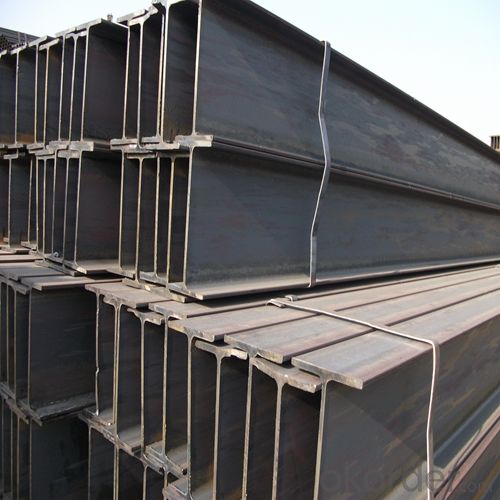
- Q: Can steel H-beams be used in the construction of religious buildings or churches?
- Yes, steel H-beams can be used in the construction of religious buildings or churches. Steel beams provide structural support, allowing for larger open spaces and flexible architectural designs. Additionally, steel is a durable and fire-resistant material, making it suitable for constructing safe and long-lasting religious structures.
- Q: Can steel H-beams be used for educational buildings?
- Indeed, educational buildings can utilize steel H-beams. These beams are frequently employed in construction owing to their robustness and structural integrity. Offering exceptional support and the ability to bear substantial loads, they are well-suited for educational buildings that feature multiple floors or expansive open spaces. Moreover, steel H-beams possess fire-resistant properties, which is an indispensable safety attribute for buildings, particularly educational ones. Additionally, steel is a resilient material that demands minimal maintenance and can endure extreme weather conditions, guaranteeing the durability of educational structures. In sum, steel H-beams are an dependable and adaptable option for the construction of educational buildings.
- Q: How do steel H-beams compare to other structural beams, such as I-beams or wooden beams?
- Steel H-beams are widely regarded as one of the most efficient and versatile structural beams available in construction. When comparing steel H-beams to other structural beams like I-beams or wooden beams, several factors come into play. Firstly, steel H-beams offer superior strength and load-bearing capacity compared to I-beams or wooden beams. The H shape of the cross-section provides a larger surface area for distributing weight, resulting in better weight-bearing capabilities. This makes steel H-beams ideal for supporting heavy loads and spanning long distances, making them a popular choice in large commercial and industrial buildings. Furthermore, steel H-beams are known for their durability and longevity. They are made from high-quality steel, which provides excellent resistance to bending, warping, and twisting. This durability ensures that steel H-beams can withstand extreme weather conditions, seismic activities, and heavy impacts, making them suitable for both indoor and outdoor applications. In terms of installation and maintenance, steel H-beams also have several advantages. They are relatively lightweight compared to other structural beams, making them easier to handle and transport during construction. Additionally, steel H-beams require minimal maintenance and are not susceptible to rot, pests, or decay like wooden beams. This significantly reduces the long-term costs associated with repairs and replacements. When compared to wooden beams, steel H-beams offer superior fire resistance. Steel is non-combustible and does not contribute to the spread of fire, making it a safer option in fire-prone areas. On the other hand, wooden beams can burn and contribute to the rapid spread of flames. Overall, steel H-beams have numerous advantages over other structural beams. Their superior strength, load-bearing capacity, durability, and fire resistance make them a preferred choice in various construction projects. While wooden beams may have their own aesthetic appeal and cost advantages, steel H-beams provide unmatched performance and longevity, making them a reliable and efficient choice in modern construction.
- Q: H steel compared with ordinary steel in the end what are the advantages and disadvantages?
- Increase the effective use area of the structure: compared with the concrete structure, the steel structure column has a small cross sectional area, thus increasing the effective use area of the building, and depending on the different forms of the building, it can increase the effective use area of 4-6%.
- Q: Are steel H-beams suitable for structures with long cantilevers?
- Yes, steel H-beams are suitable for structures with long cantilevers. H-beams are known for their high strength and load-bearing capacity, making them ideal for supporting long overhanging sections. The shape of the H-beam provides excellent resistance to bending and torsion forces, ensuring stability and structural integrity in cantilevered structures.
- Q: What are the common methods for joining steel H-beams in construction?
- Steel H-beams can be joined in construction using various methods. The most frequently employed technique is welding, where the beams are aligned and fused together through arc welding or gas welding. This creates a sturdy and long-lasting connection, ensuring the structural integrity of the beams. Another method involves using bolts to connect the steel H-beams. Holes are drilled into the flanges, and bolts are inserted through these holes and tightened with nuts. This allows for easy disassembly and reassembly if required. Riveting is an alternative method that involves using rivets to join the steel H-beams. Holes are drilled into the flanges and web, and rivets are inserted and secured through hammering or pressing. However, this method is time-consuming and has been largely replaced by welding and bolted connections. In some cases, adhesive bonding can be used to join steel H-beams. High-strength adhesives are applied to the surfaces of the beams, and they are then pressed together. Although not as commonly used as welding or bolted connections, adhesive bonding can be a viable option in certain situations. Overall, welding and bolted connections are the predominant methods for joining steel H-beams in construction. These techniques provide robust and reliable connections, ensuring the stability and integrity of the structure.
- Q: What are the different fabrication methods for steel H-beams?
- There are several different fabrication methods used for manufacturing steel H-beams. These methods include hot rolling, cold rolling, and welding. Hot rolling is the most common method used for fabricating steel H-beams. In this process, a billet of steel is heated to a high temperature and then passed through a series of rolling stands to shape it into the desired H-beam profile. The high temperature makes the steel more malleable, allowing it to be easily formed into the H-shape. This method results in high-quality H-beams with excellent structural integrity. Cold rolling is another fabrication method used for steel H-beams. In this process, the steel is passed through a series of rolling stands at room temperature. The cold rolling process helps to improve the surface finish and dimensional accuracy of the H-beams. It is often used for producing smaller and lighter H-beams, which are commonly used in applications where weight and size are critical factors. Welding is also used for fabricating steel H-beams. In this method, individual steel plates or sections are welded together to form the H-beam shape. Welding allows for greater flexibility in terms of the size and shape of the H-beam, making it suitable for custom or non-standard applications. However, welded H-beams may have lower structural integrity compared to those produced through hot or cold rolling. Overall, the choice of fabrication method for steel H-beams depends on various factors, including the size, shape, and application requirements. Each method has its own advantages and limitations, and manufacturers carefully select the most suitable method based on the specific needs of the project.
- Q: What are the different types of steel H-beam connections used in retail buildings?
- Retail buildings utilize various types of steel H-beam connections to ensure the structural integrity and stability. Some commonly employed connections include: 1. Welded Connection: This connection is extensively utilized in retail buildings, involving the welding of one H-beam's flange to another H-beam's web, resulting in a robust bond. Welded connections are renowned for their superior strength and durability. 2. Bolted Connection: Bolted connections utilize bolts and nuts to connect the flanges of two H-beams. This connection offers flexibility as it enables effortless disassembly and reassembly when necessary. Moreover, bolted connections are cost-effective and suitable for areas where welding is not preferable. 3. Gusset Plate Connection: This connection employs a gusset plate to join the flanges of two H-beams. Typically composed of steel, the gusset plate is either bolted or welded to the flanges. This connection enhances the structure's strength and stability. 4. Moment Connection: Moment connections are employed in areas predicted to experience high bending moments. These connections provide rotational stiffness and transfer moments from one H-beam to another, thereby ensuring the overall stability of the structure. 5. Shear Connection: Shear connections facilitate the transfer of shear forces between H-beams. Bolts or welds are utilized to join the webs of two H-beams together in these connections. Shear connections are vital for ensuring the structure's overall stability and load-bearing capacity. 6. Bracing Connection: Bracing connections offer additional lateral support to the structure. Diagonal braces are connected to the H-beams using bolts or welds in these connections. Bracing connections effectively resist lateral forces such as wind or seismic loads, thereby enhancing the retail building's overall stability and safety. When selecting and designing H-beam connections for retail buildings, it is crucial to consult with structural engineers and adhere to local building codes and regulations. The choice of connection depends on factors such as structural requirements, architectural design, and the specific loads acting on the structure.
- Q: Can steel H-beams be used in gymnasium structures?
- Certainly, gymnasium structures can incorporate steel H-beams. Thanks to their robustness and durability, steel H-beams are frequently employed in construction projects. They offer remarkable stability and support, rendering them ideal for expansive areas such as gymnasiums. Furthermore, steel H-beams can be readily tailored and fabricated to meet the precise design prerequisites of a gymnasium. They possess the ability to endure substantial loads and guarantee the essential structural integrity requisite for gymnasium structures.
- Q: What are the different types of steel H-beam connections for seismic-resistant buildings?
- There are several different types of steel H-beam connections that can be used in seismic-resistant buildings. These connections are specifically designed to withstand the forces and vibrations experienced during earthquakes, ensuring the structural integrity of the building. Some of the commonly used types of steel H-beam connections for seismic-resistant buildings include: 1. Welded connections: This is the most common type of connection used in seismic-resistant buildings. Welded connections involve joining the H-beams together using various welding techniques such as fillet welds or groove welds. Welded connections provide excellent strength and stiffness, making them suitable for seismic applications. 2. Bolted connections: Bolted connections involve using bolts and nuts to join the H-beams together. These connections offer ease of installation and flexibility for future modifications or repairs. However, they may not provide the same level of stiffness as welded connections. 3. Moment connections: Moment connections are designed to transfer both vertical and horizontal forces between H-beams while allowing rotational movement. This type of connection is commonly used in beam-to-column joints and provides enhanced resistance against seismic forces by allowing controlled plastic deformation. 4. Shear connections: Shear connections are used to transfer vertical loads between H-beams. These connections are designed to resist shearing forces and prevent the beams from sliding relative to each other. Shear connections are essential for maintaining the stability of the structure during seismic events. 5. Composite connections: Composite connections involve combining steel H-beams with other materials such as concrete or timber. These connections offer enhanced strength, stiffness, and ductility, making them suitable for seismic-resistant buildings. 6. Moment-resisting connections: Moment-resisting connections, also known as rigid connections, provide high resistance against lateral forces. These connections are designed to maintain rigidity and prevent rotation between H-beams and other structural elements, ensuring the building remains stable during seismic events. It is essential to consult with structural engineers and adhere to local building codes and regulations when selecting and designing steel H-beam connections for seismic-resistant buildings. The specific type of connection used will depend on factors such as the building design, anticipated seismic forces, and desired level of performance.
Send your message to us
Hot Rolled H-Beam Structure Steel Q235 High Quality Good Price
- Loading Port:
- Tianjin
- Payment Terms:
- TT OR LC
- Min Order Qty:
- 500 m.t.
- Supply Capability:
- 5000 m.t./month
OKorder Service Pledge
OKorder Financial Service
Similar products
Hot products
Hot Searches
Related keywords
